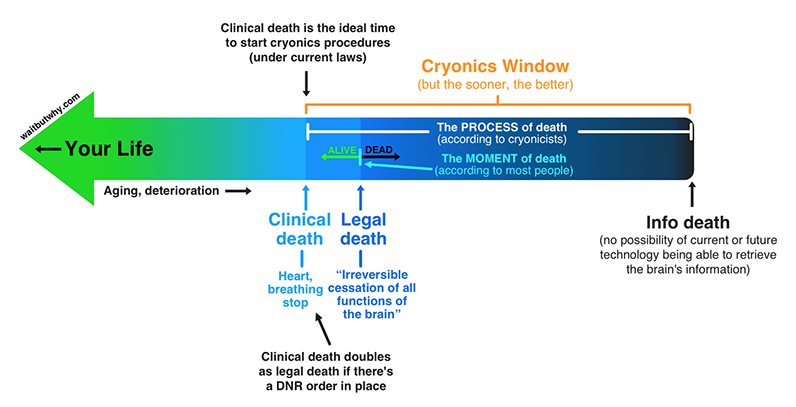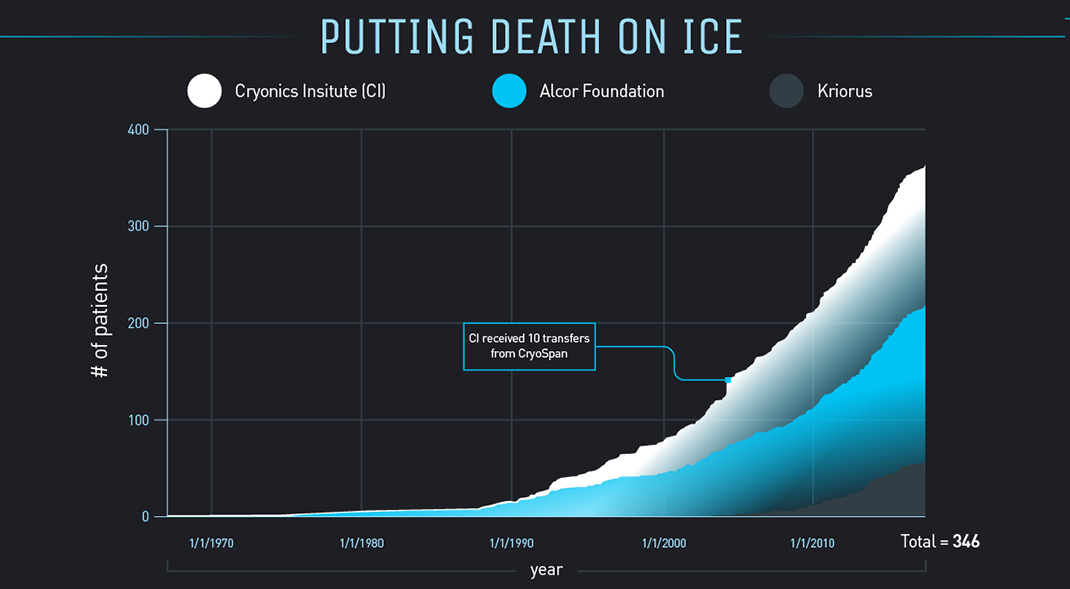Technology
Cryonics: Putting Death on Ice

Cryonics: Putting Death on Ice
There is a potent thread winding its way through generations of human culture. From Ancient Egyptian rituals to Kurzweil’s Singularity, many paths have sprung up leading to the same elusive destination: immortality.
Today, the concept is as popular as it’s ever been, and technological advances are giving people hope that immortality, or at very least radical life extension, may be within reach. Is modern technology advanced enough to give people a second chance through cryonics?
Today’s infographic, courtesy of Futurism, tackles our growing fascination with putting death on ice.
The Prospect of Immortality
Robert C. W. Ettinger’s seminal work, The Prospect Of Immortality, detailed many of the scientific, moral, and economic implications of cryogenically freezing humans for later reanimation. It was after that book was published in 1962 that the idea of freezing one’s body after death began to take hold.
One of the most pressing questions is, even if we’re able to revive a person who has been cryogenically preserved, will the person’s memories and personality remain intact? Ettinger posits that long-term memory is stored in the brain as a long-lasting structural modification. Basically, those memories will remain, even if the brain’s “power is turned off”.
Descending into the Deep-Freeze
There are three main steps in the cryogenic process:
1) Immediately after a patient dies, the body is cooled with ice packs and transported to the freezing location.
2) Next, blood is drained from the patient’s body and replaced with a cryoprotectant (basically the same antifreeze solution used to transport organs destined for transplant).
3) Finally, once the body arrives at the cryonic preservation facility, the body is cooled to -196ºC (-320.8ºF) over the course of two weeks. Bodies are generally stored upside-down in a tank of liquid nitrogen.
The Economics of Cryopreservation
At prices ranging from about $30,000 to $200,000, cryopreservation may sound like an option reserved for the wealthy, but many people fund the procedure by naming a cryonics company as the primary benefactor of their life insurance policy. Meanwhile, in the event of a death that doesn’t allow for preservation of the body, the money goes to secondary beneficiaries.
Even if we do eventually find a way to reanimate frozen humans, another important consideration is how those people would take care of themselves financially. That’s where a cryonics or personal revival trust comes into play. A twist on a traditional dynastic trust, this arrangement ensures that there are funds to cover costs of the cryopreservation, as well as ensure the grantor would have assets when they’re unthawed. Of course, there are risks involved beyond the slim possibility of reanimation. The legal code in hundreds of years could be vastly different than today.
If you created a trust for specific purposes in 1711, it is unlikely it would function in the same way today.
– Kris Knaplund, Law Professor, Pepperdine University
Cold Humans, Hot Market
At last count, there are already 346 people in the deep freeze, with thousands more on the waiting list. As technology improves, those numbers are sure to continue rising.
Time will tell whether cryonically preserved people are able to cheat death. In the meantime? The cryonics industry is alive and well.
Technology
All of the Grants Given by the U.S. CHIPS Act
Intel, TSMC, and more have received billions in subsidies from the U.S. CHIPS Act in 2024.

All of the Grants Given by the U.S. CHIPS Act
This was originally posted on our Voronoi app. Download the app for free on iOS or Android and discover incredible data-driven charts from a variety of trusted sources.
This visualization shows which companies are receiving grants from the U.S. CHIPS Act, as of April 25, 2024. The CHIPS Act is a federal statute signed into law by President Joe Biden that authorizes $280 billion in new funding to boost domestic research and manufacturing of semiconductors.
The grant amounts visualized in this graphic are intended to accelerate the production of semiconductor fabrication plants (fabs) across the United States.
Data and Company Highlights
The figures we used to create this graphic were collected from a variety of public news sources. The Semiconductor Industry Association (SIA) also maintains a tracker for CHIPS Act recipients, though at the time of writing it does not have the latest details for Micron.
| Company | Federal Grant Amount | Anticipated Investment From Company |
|---|---|---|
| 🇺🇸 Intel | $8,500,000,000 | $100,000,000,000 |
| 🇹🇼 TSMC | $6,600,000,000 | $65,000,000,000 |
| 🇰🇷 Samsung | $6,400,000,000 | $45,000,000,000 |
| 🇺🇸 Micron | $6,100,000,000 | $50,000,000,000 |
| 🇺🇸 GlobalFoundries | $1,500,000,000 | $12,000,000,000 |
| 🇺🇸 Microchip | $162,000,000 | N/A |
| 🇬🇧 BAE Systems | $35,000,000 | N/A |
BAE Systems was not included in the graphic due to size limitations
Intel’s Massive Plans
Intel is receiving the largest share of the pie, with $8.5 billion in grants (plus an additional $11 billion in government loans). This grant accounts for 22% of the CHIPS Act’s total subsidies for chip production.
From Intel’s side, the company is expected to invest $100 billion to construct new fabs in Arizona and Ohio, while modernizing and/or expanding existing fabs in Oregon and New Mexico. Intel could also claim another $25 billion in credits through the U.S. Treasury Department’s Investment Tax Credit.
TSMC Expands its U.S. Presence
TSMC, the world’s largest semiconductor foundry company, is receiving a hefty $6.6 billion to construct a new chip plant with three fabs in Arizona. The Taiwanese chipmaker is expected to invest $65 billion into the project.
The plant’s first fab will be up and running in the first half of 2025, leveraging 4 nm (nanometer) technology. According to TrendForce, the other fabs will produce chips on more advanced 3 nm and 2 nm processes.
The Latest Grant Goes to Micron
Micron, the only U.S.-based manufacturer of memory chips, is set to receive $6.1 billion in grants to support its plans of investing $50 billion through 2030. This investment will be used to construct new fabs in Idaho and New York.
-

 Brands6 days ago
Brands6 days agoHow Tech Logos Have Evolved Over Time
-

 Economy2 weeks ago
Economy2 weeks agoWhere U.S. Inflation Hit the Hardest in March 2024
-

 Green2 weeks ago
Green2 weeks agoTop Countries By Forest Growth Since 2001
-

 United States2 weeks ago
United States2 weeks agoRanked: The Largest U.S. Corporations by Number of Employees
-

 Maps2 weeks ago
Maps2 weeks agoThe Largest Earthquakes in the New York Area (1970-2024)
-

 Green2 weeks ago
Green2 weeks agoRanked: The Countries With the Most Air Pollution in 2023
-

 Green2 weeks ago
Green2 weeks agoRanking the Top 15 Countries by Carbon Tax Revenue
-

 Markets2 weeks ago
Markets2 weeks agoU.S. Debt Interest Payments Reach $1 Trillion














